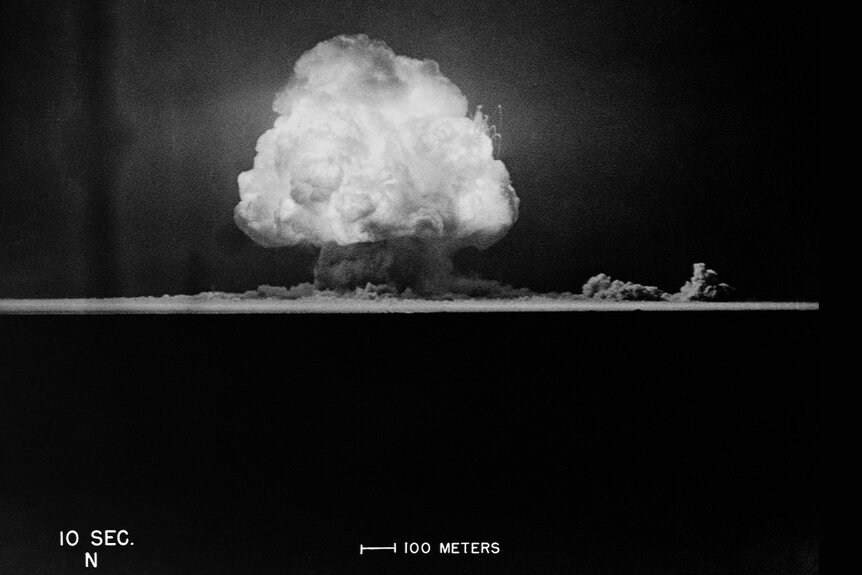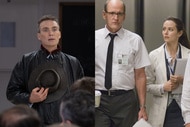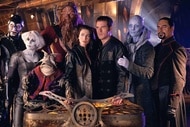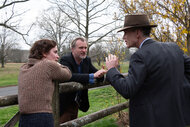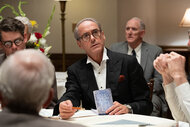Create a free profile to get unlimited access to exclusive videos, sweepstakes, and more!
Could Oppenheimer’s Atomic Bomb Really Have Destroyed the World?
From a certain point of view, it remains to be seen.
Almost exactly 78 years ago, on July 16, 1945, a group of scientists detonated a new kind of weapon in the New Mexico desert. That first atomic bomb test ushered in a new kind of warfare and a new, more frightening world. After having witnessed the first test, J. Robert Oppenheimer, often called the “father of the atomic bomb,” famously quoted a line of Hindu scripture from the Bhagavad-Gita: “Now I am become Death, the destroyer of worlds.”
RELATED: Oppenheimer First Reactions: Christopher Nolan's "Stunning" New Film Praised as A "Total Knockout"
With any luck, none of us will ever see what Oppenheimer saw, firsthand, but we can go see it at the movies on Friday, July 21, 2023. Christopher Nolan’s Oppenheimer, starring Cillian Murphy as the titular physicist, is based on Kai Bird and Martin J. Sherwin’s 2005 biography American Prometheus: The Triumph and Tragedy of J. Robert Oppenheimer, which chronicles Oppenheimer's life and his involvement in the development of nuclear weapons.
How Does an Atom Bomb Work?
When you split an atom, a process known as fission, the resulting release of energy is immensely powerful. When that reaction is safely contained, you can capture the released energy and use it to power toasters, lightbulbs, and television sets for millions of people. When uncontained, you can destroy just about anything. You might even be able — it was once believed — to destroy the world itself.
The scientists at the Manhattan Project were no slouches, they obviously knew what they were doing, but they were also playing with powerful forces at the fringes of human knowledge. A little bit of caution was warranted.
Here’s what they were dealing with.
When a neutron hits the nucleus of a radioactive uranium or plutonium isotope, it causes deformations in the nucleus from which the atom can’t recover. The atom splits in two, releasing a whole bunch of energy and radioactivity in the process. It also releases at least a couple of neutrons which, if you recall, are what caused the first atom to split. If there’s enough fissionable material nearby — referred to as a critical mass — then those released neutrons will hit another nucleus, causing another fission event, and so on in a chain reaction.
For an atomic bomb to work, you want this chain reaction to happen, but you don’t want it to go on forever.
Three years before the Manhattan Project's first nuclear test, a small group of physicists considered the idea that a nuclear explosion set off in the air might set off a chain reaction igniting the atmosphere. The notion was first suggested by physicist Edward Teller, who spoke with colleagues including Hans Bethe and, yes, Oppenheimer.
Teller’s concern, roughly speaking, was that the energy from the blast might be sufficient to fuse nitrogen in the atmosphere into carbon and oxygen. The idea sounds silly today (those are the sorts of fusion reactions that occur inside the cores of massive late-stage stars), but at the time no one was entirely sure what would happen when the bomb went off.
Physicists crunched the numbers and were pretty certain the atmosphere wouldn’t ignite. The math just didn’t work out. In fact, before the test, Enrico Fermi casually offered a bet that a couple of scientists reportedly took. The attitude surrounding the possibility of fire in the sky was, apparently, casual.
Still, the possibility was taken seriously and investigated thoroughly. Arthur Compton, a Nobel Prize-winning physicists once said of the question, “It would be the ultimate catastrophe. Better to accept the slavery of the Nazis than to run the chance of drawing the final curtain on mankind!” He only agreed to the test after calculating the odds of a runaway reaction at less than one in 3 million, per Scientific American.
Did Oppenheimer Use A Real Nuke?
No, the Christopher Nolan film Oppenheimer did not use a real atomic bomb to recreate its life-like explosion.
There’s more than one way to destroy the world
Of course, we got the answer in time. The first test didn’t ignite the sky, nor did the subsequent tests or the wartime detonations over Hiroshima and Nagasaki. Still, the threat of nuclear detonation remains very real.
We have, so far, avoided all-out nuclear war. In fact, after the detonations at Nagasaki and Hiroshima during World War II, no nuclear weapon has ever again been deployed against human beings. However, until there is full-fledged nuclear disarmament, the threat of the end of the world will remain.
In addition to the primary effects of the explosion, there would be downstream consequences of global nuclear war that would reshape the face of the planet for the worse. Recently, a group of scientists ran simulations on a number of different nuclear conflicts to see what would happen. They simulated small regional wars with a relatively small number of detonations between neighboring nations and a global nuclear war with thousands of detonations all over the planet. In every case, explosions released enough soot and smoke into the air to block out the Sun.
In that case, temperatures would drop more than 10 degrees on average across the world. Crops would fail and populations of wild plants and animals would diminish. In short, the total available resources on our planet would plummet, and the loss of human life would be staggering. Scientists estimate losses counted in the billions.
There isn’t a nuclear bomb on Earth that could actually destroy the world, but they could destroy the world as we know it. And that’s pretty much the same thing.
Oppenheimer hits theaters on Friday July 21, 2023. Get your tickets now!




